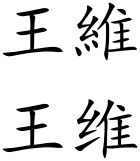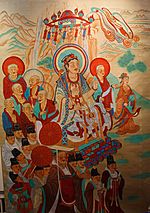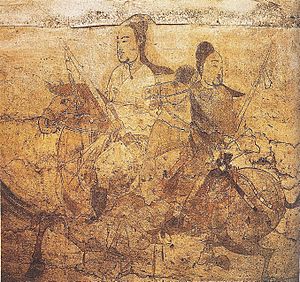Wang Wei (Tang dynasty) facts for kids
Quick facts for kids
Wang Wei
|
|
|---|---|
 |
|
| Born | 699 Qi County, Jinzhong, Shanxi |
| Died | 759 (aged 59–60) Xi'an, Shaanxi |
| Occupation | Politician, painter, musician, poet |
| Period | Tang Dynasty |
| Wang Wei | |||||||||||||||||||
|---|---|---|---|---|---|---|---|---|---|---|---|---|---|---|---|---|---|---|---|

Wang's name in Traditional (top) and Simplified (bottom) Chinese characters
|
|||||||||||||||||||
| Traditional Chinese | 王維 | ||||||||||||||||||
| Simplified Chinese | 王维 | ||||||||||||||||||
|
|||||||||||||||||||
| Mojie | |||||||||||||||||||
| Traditional Chinese | 摩詰 | ||||||||||||||||||
| Simplified Chinese | 摩诘 | ||||||||||||||||||
|
|||||||||||||||||||
| Householder Mojie | |||||||||||||||||||
| Traditional Chinese | 摩诘居士 | ||||||||||||||||||
| Simplified Chinese | 摩詰居士 | ||||||||||||||||||
| Literal meaning | See Householder | ||||||||||||||||||
|
|||||||||||||||||||
Wang Wei (Chinese: 王維; 699–759) was a famous Chinese artist and government official. He lived during the Tang Dynasty, a very important time in Chinese history. Wang Wei was known for many talents: he was a poet, a musician, a painter, and a politician.
He was one of the most celebrated artists and thinkers of his time. Many of his poems are still around today. Twenty-nine of them were even put into a famous book called Three Hundred Tang Poems.
Contents
Wang Wei's Names and Meanings
Wang Wei's family name was Wang, and his first name was Wei. He also chose a special courtesy name, Mojie. He would often sign his artworks as Wang Weimojie.
This name, Wei-mo-Jie (維摩詰), was a nod to Vimalakirti. Vimalakirti was a key figure in a Buddhist holy book called a sutra. In this book, Vimalakirti, who was a regular person, teaches about "emptiness" or Sunyata. He even teaches important Buddhist figures like arhats and bodhisattvas.
Wang Wei's Life and Talents
Wang Wei is especially famous for his poems and paintings about nature. About 400 of his poems have survived. His younger brother, Wang Jin, collected and organized them.
Sadly, none of his original paintings are still around today. But we know about his painting style from other artists who were influenced by him. People also wrote descriptions of his paintings. Wang Wei was also a very talented musician, but none of his music has survived either.
Besides his artistic skills, he had a successful career as a government official. Later in his life, he became a strong follower of Zen Buddhism. He even became a vegetarian. Wang Wei spent ten years learning from a Buddhist master named Daoguang.
His Early Life and Career
Wang Wei was born into an important family. They were Han Chinese and originally from Qi County in Shanxi province. His father moved the family to Puzhou, which is now Yongji, Shanxi.
Wang Wei was very smart from a young age. He was the oldest of five brothers. At 19, he went to the capital city, Chang'an, to study. He wanted to take the jinshi civil service exam. This exam was how people got important government jobs.
While in Chang'an, Wang Wei became popular at the royal court. This was thanks to his amazing poetry and his skill with the pipa, a Chinese musical instrument. In 721, he passed the jinshi exam with the highest honors. This started his promising career in government.
Wang Wei's career had its ups and downs. His first job was as a court musician. But he was then moved to a less important job in charge of a granary. Some stories say this happened because he broke etiquette by performing a lion dance.
This was only a small setback. It even allowed him to travel more. Later, he was promoted several times. This was likely because of his connection with a powerful government minister and poet, Zhang Jiuling. By 728, Wang Wei was back in Chang'an. He became good friends with the poet Meng Haoran.
Wang Wei continued to work in government. After his wife passed away in 731, he never remarried. As an official, Wang Wei was sent to Liangzhou. This was a frontier area in the northwest of the Chinese empire. There were often military conflicts there. He served there until returning to Chang'an in 738 or 739.
A Love for Nature and Buddhism
After returning to Chang'an, Wang Wei didn't have an official job right away. He used this time to explore the countryside south of the capital. This area was in the Zhongnan Mountains, near Lantian County. Here, Wang Wei became friends with Pei Di.
From 740 to 741, Wang Wei's government career became successful again. He went on an inspection tour and held various positions in Chang'an. His government salary and earnings as an artist allowed him to buy a large estate. This estate, called Wang Chuan, was in Lantian. It had belonged to another poet, Song Zhiwen.
At his Lantian estate, Wang Wei built a shrine for his Buddhist mother. When she died in 747 or 748, he spent three years mourning there. He was so sad that he became very thin. By 751 or 752, Wang Wei was back to his official duties.
Life During Wartime
A major event called the An Lushan Rebellion (755–763) greatly affected China. In 756, Wang Wei was in the capital, Chang'an. When the rebels took the city, he was captured. The emperor and most officials had already left for Sichuan. But Wang Wei was sick and couldn't travel.
The rebels took him to their capital, Luoyang. They wanted him to work for their government. Some stories say he pretended to be deaf to avoid helping them. Others say he drank medicine to hurt his voice. Either way, he couldn't avoid becoming an official for the rebels.
In 757, the Tang government took back Luoyang. Wang Wei was arrested as a suspected traitor. But the charges were dropped. This was partly because his brother, Wang Jin, helped him. Wang Jin was a high-ranking official and was known for his loyalty. Also, poems Wang Wei wrote while captured proved his loyalty.
After being pardoned, Wang Wei spent much time on his Buddhist practices. He then got another government job in 758. It was a lower position at first, working for the crown prince. But in 759, he was back in the emperor's court. He was even promoted to a very high position, like a deputy prime minister. He held this job until he died in 761. These jobs were in Chang'an, so he could still visit and fix up his private estate. He continued his artistic work during this time.
Later Years and Legacy
Wang Wei never saw the empire fully return to peace. The An-Shi rebellion and its aftermath continued after his death. However, he did enjoy more stability in his later years. He could spend time at his quiet Lantian estate. This was a place for him to write poetry, practice Buddhism, and enjoy nature with friends.
His writing eventually came to an end. In 759 or 761, Wang Wei asked for writing tools. He wrote letters to his brother and friends, and then he passed away. He was buried at his Lantian estate.
Wang Wei's Amazing Works

Wang Wei was famous for both his poetry and his paintings. A famous writer, Su Shi, once said: "The quality of Wang Wei’s poems can be summed as, the poems hold a painting within them. In observing his paintings you can see that, within the painting there is poetry."
He was especially known for his "Mountains and Streams" (Shanshui) poetry. This was a type of landscape poetry. He and Meng Haoran were so good at it that people often called them "Wang Meng." In his later years, Wang Wei became more interested in Buddhism. His poems showed his focus on Chan practice. Because of this, he was later called the "Poet Buddha."
His works are collected in Secretary General Wang's Anthology, which has 400 poems. He was skilled at painting people, bamboo forests, and mountain and river scenes. It is said that his landscape paintings had two styles. One was like the Li Family's style, and the other used strong brush strokes. His painting Picture of Wang River was in the second style, but the original is lost. His works like Scenery of Snow and Creek and Jinan’s Fusheng Portrait were very realistic.
Poetry: Pictures in Words
Today, about 420 poems are believed to be by Wang Wei, with 370 thought to be truly his. Wang Wei was a master of the jueju, a type of four-line poem called a quatrain. Many of his quatrains show quiet scenes of water and mist. They have few details and little human presence.
His poems show the beauty of the world. Yet, they also make you think about whether things are truly real. His poems seem simple, but they have deep meaning. This is like the Chan path to enlightenment, which needs careful preparation but is achieved without conscious effort.
Here is one of Wang Wei's famous poems, "One-hearted" (Xiang Si 相思):
| Original Chinese | English Translation |
|---|---|
|
|
The Wang River Collection
Some of Wang Wei's most famous poetry was a collaboration with his friend Pei Di. They wrote a series of poems together, with each writing a couplet (two lines). These poems are called the Wang River Collection. The "Wang" in "Wang River" is a different Chinese character from Wang Wei's name.
These poems are sometimes called the "Lantian poems." This is because they were inspired by Wang Wei's estate in Lantian and the nature around it. The collection includes poems like "Deer Park" (which means "Deer Fence"). These poems seem simple, but they are actually very deep and complex when you look closely.
Painting: A New Style
Wang Wei is seen as the founder of the Southern School of Chinese landscape art. This painting style used strong brushstrokes along with light ink washes.
Critical editions
- Wang Youcheng Ji Jianzhu 《王右丞集箋注》 (An Annotated Edition of the Collected Works of Wang [Wei] the Right Assistant Secretary of State Affairs). Edited by Zhao Diancheng (趙殿成) (1683–1756). Shanghai: Shanghai Ancient Books Publishing House, 1961.
See also
 In Spanish: Wang Wei para niños
In Spanish: Wang Wei para niños



